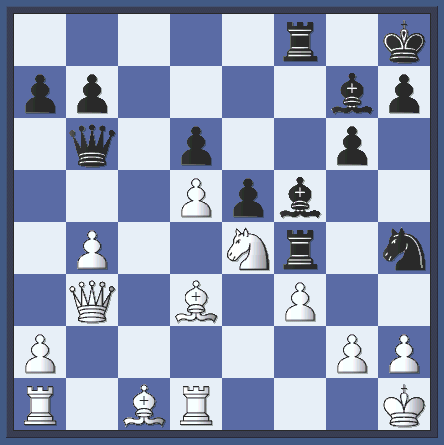All
the |
(Navigation bar
directly below.)
*******
© A.J. Goldsby, 2015.
(All rights reserved.)
****************
Click HERE
to see my
Chess Items.
****************
****************
Buy a book
from Amazon.com
(And help me out as well!)
****************
Click HERE
...
to see a list of the businesses that help to sponsor all of
my chess efforts.
|
|
|---|
This is the first game of my tactical school. The more you study and go over this game, the more you will begin to be able to understand and use the ideas. I advise repeated study. This game could be studied 2-3 hours, (at one time); in a tactical vein. It could also be studied for 30-90 minutes at a time during your openings study. (See the parent page for details.)
I STRONGLY advise that you study the plain, un-annotated versions of this game, (Click HERE.); before you even look at the annotated version of this game. (See the parent page for details.)
GM
E. Bacrot (2653) - R. Kasimdzhanov (2674)
|
|
|
The
key position. Black to play his 23rd move.
What is the correct move here?
[ After 23.a4!? Nxg2!!; "--->" {Diagram?} Black has a strong attack.
***
The pawn fork, g2-to-g3, does not work:
23.g3? Rxf3; 24.Re1, {Diag?}
This could be forced.
(24.gxh4?? Bxe4; "-/+" {D?} Notice the pin along the third rank here.)
24...Bg4; 25.Ng5 Qf2;
"/+" {Diagram?}
Black is much better here.
- I think Black
has a winning attack here. (Maybe even "-/+")
Maybe the best move was: 23.Rac1, {D?} with a fair position for White. ]
Now Black unleashes a devastating combination of great power.
One of the KEYS to
getting better ... and seeing and/or anticipating these
types of
sacrifices, is to play through dozens and dozens of games for this
type.
After a while, you will develop an instinct for when it is time to
sacrifice.
23...Nxg2!!;
An incredible tactical shot.
The main idea is quite simple, Black hopes to rip away the pawn cover
in front of the White King; exposing the White leader to the full
fury of
Black's attack.
24.Kxg2?!,
(Maybe - '?')
This
may be forced. Or it may lose by force.
That does not matter to us here!
Our main goal is to work out the King hunt down to a conclusion.
[ Maybe
better was: >= 24.Bxf4 Nxf4; "=/+" {Diagram?}
but Black has a continuing
(very strong) K-side attack. ]
24...Rxf3!;
Another
thunderous shot.
(But really the only follow-up to the sacrifice on g2.)
[ Several of my students have
suggested the continuation:
24...Bxe4;
25.Bxe4, Rxe4; etc; with an attack.
(A big check is coming
on f2.) ]
25.Qc4,
This looks like the best move here for
White.
[ It is suicide if White takes:
25.Kxf3? Bxe4+; 26.Kg4,
{Diag?}
This might be best.
(26.Kxe4? Qd4#; or 26.Kg3 Qf2+;
27.Kh3 Qg2+; 28.Kh4
Bf6+;
29.Bg5 Bxg5#)
26...h5+; 27.Kh3,
{Diagram?}
Once again, this could be
forced.
(27.Kg5? Qd8#; or 27.Kh4 Qf2+; 28.Kg5 Qf6#)
27...Rf3+; 28.Kh4 Bf6+; 29.Bg5 Qf2#.
{Diagram?}
Study this line
very carefully!! It is the
whole reason
for the tactical school I have started.
***
After Qc2, Black has a relatively simple win. I.e. 25.Qc2?! Bxe4;
26.Bxe4 Rf2+;
{Diagram?} The Rook on f2, supported by its partner
on f8, FORKS the
White King and Queen.
(Of course, Black is
winning. "-/+") ]
25...Rxd3!!;
Yet another incredible tactical shot.
(Most of my students have NOT seriously considered this move,
and/or looked at it last.)
[ Most of my students want to
play other moves here, i.e.,
25...Bxe4!?,
or 25...Rf2+!?, or
even 25...Bh3+;
{Diagram?}
all with various
degrees of success. ]
26.Rxd3,
This could be forced.
[ Much worse would be:
</= 26.Rxd3?!, Qxb4; "/+"
(or even "+/-") {Diag?}
Black hits and wins e4. The
variations are very long, some are very complex.
(You may work these out for
yourself!) But the basic idea is relatively simple. ]
26...Rc8; ('!') 27.Qxc8+,
Now this is forced.
[ Much less attractive (really
inferior) is:
27.Qb3 Bxe4+;
28.Rf3, {Diagram?}
This is forced.
(28.Kh3?!
Qg1; "-/+"
The computer says it is mate in six or seven moves.)
28...Qd4; 29.Bb2 Bxf3+; 30.Kxf3 Rf8+;
"-/+" {Diag?}
Black has
a winning attack. ]
Black now has a win.
The aspiring student should
study Black's winning technique over and over
and over(!) again ...
until he completely understands the process.
27...Bxc8; 28.Bd2
Bf5; 29.Re1 Qb5; 30.Rde3 Qxd5!?;
This is nice, but
did Black miss an even better move, leading to a quicker win?
[ It seems
better was: >= 30...Bh6!; 31.Nc3
Qxb4; 32.Nb1 Qc4;
33.Nc3
Qd4!;
{Diagram?} with overwhelming pressure. ]
31.Bc3 Bh6;
32.R3e2 Qd3; 33.Ba1 Bxe4+!?;
This wins ... but Black actually had
TWO moves ...
that were better than this one!
[ Black could play: = 33...Bh3+!; with a winning attack.
The best move
probably was: >/= 33...Bg4!; 34.Nf2,
{Diag?}
This appears nearly
forced. (34.Rf2!? Be3)
34...Qd5+; 35.Re4,
{D?}
Otherwise
White loses a Rook. (35.Kf1 Bxe2+; "-/+")
35...Bd2!; ("-/+")
{Diagram?} Black is winning
MUCH more
material, White's position is
completely hopeless. Note that White's
Bishop on a1 is not in play at all. ]
White plays on ... perhaps
through inertia.
34.Rxe4 Kg8; 35.Bxe5?! dxe5; 36.Rxe5
Bf8; 37.b5 Bd6;
38.Re8+ Kf7; 39.R8e4 Qxb5, "+/-"
White could resign here.
40.h4 Qd5;
41.R1e2 b5; 42.Kf1 b4; 43.R4e3 Qh1+;
44.Kf2 Bc5; "-/+" (White
Resigns.)
A tremendous game by Black.
A GREAT game to study
... especially to improve your
tactics.
(Study it over and over!)
(Code initially) Generated with ChessBase 8.0
0 - 1
Click HERE to return to my home page.
(Page last updated: Thursday; January 30th, 2003.) Last edit/save on: 04/14/2014 .
Copyright (c) A.J. Goldsby I
Copyright (©) A.J. Goldsby, 1985-2014.
Copyright (©) A.J. Goldsby, 2014. All rights reserved.

